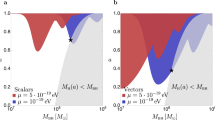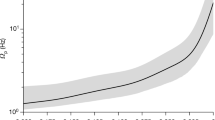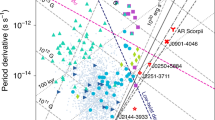Abstract
The spin of a black hole retains the memory of how the black hole grew, and can be a potent source of energy for powering relativistic jets. To understand the diagnostic power and astrophysical significance of black hole spin, however, we must first devise observational methods for measuring spin. Here, I describe the current state of black hole spin measurements, highlighting the progress made by X-ray astronomers, as well as the current excitement of gravitational wave- and radio astronomy-based techniques. Today’s spin measurements are already constraining models for the growth of supermassive black holes and giving new insights into the dynamics of stellar core collapse, as well as hinting at the physics of relativistic jet production. Future X-ray, radio and gravitational wave observatories will transform black hole spin into a precision tool for astrophysics and test fundamental theories of gravity.
This is a preview of subscription content, access via your institution
Access options
Access Nature and 54 other Nature Portfolio journals
Get Nature+, our best-value online-access subscription
$29.99 / 30 days
cancel any time
Subscribe to this journal
Receive 12 digital issues and online access to articles
$119.00 per year
only $9.92 per issue
Buy this article
- Purchase on Springer Link
- Instant access to full article PDF
Prices may be subject to local taxes which are calculated during checkout




Similar content being viewed by others
References
Israel, W. Event horizons in static vacuum space-times. Phys. Rev. 164, 1776–1779 (1967).
Carter, B. Axisymmetric black hole has only two degrees of freedom. Phys. Rev. Lett. 26, 331–333 (1971).
Blandford, R. D. & Znajek, R. L. Electromagnetic extraction of energy from Kerr black holes. Mon. Not. R. Astron. Soc. 179, 433–456 (1977).
Fabian, A. C. Observational evidence of active galactic nuclei feedback. Annu. Rev. Astron. Astrophys. 50, 455–489 (2012).
Volonteri, M., Madau, P., Quataert, E. & Rees, M. J. The distribution and cosmic evolution of massive black hole spins. Astrophys. J. 620, 69–77 (2005).
Miller, M. C. & Miller, J. M. The masses and spins of neutron stars and stellar-mass black holes. Phys. Rep. 548, 1–34 (2015).
Kerr, R. P. Gravitational field of a spinning mass as an example of algebraically special metrics. Phys. Rev. Lett. 11, 237–238 (1963).
Penrose, R. & Floyd, R. M. Extraction of rotational energy from a black hole. Nat. Phys. Sci. 229, 177–179 (1971).
Bambi, C. Spinning super-massive objects in galactic nuclei up to a * > 1. Europhys. Lett. 94, 50002 (2011).
Shakura, N. I. & Sunyaev, R. A. Black holes in binary systems. Observational appearance. Astron. Astrophys. 24, 337–355 (1973).
Reynolds, C. S. & Fabian, A. C. Broad iron-Kα emission lines as a diagnostic of black hole spin. Astrophys. J. 675, 1048–1056 (2008).
Shafee, R. et al. Three-dimensional simulations of magnetized thin accretion disks around black holes: stress in the plunging region. Astrophys. J. Lett. 687, L25 (2008).
Bardeen, J. M., Press, W. H. & Teukolsky, S. A. Rotating black holes: locally nonrotating frames, energy extraction, and scalar synchrotron radiation. Astrophys. J. 178, 347–370 (1972).
Fabian, A. C. et al. Properties of AGN coronae in the NuSTAR era. Mon. Not. R. Astron. Soc. 451, 4375–4383 (2015).
George, I. M. & Fabian, A. C. X-ray reflection from cold matter in active galactic nuclei and X-ray binaries. Mon. Not. R. Astron. Soc. 249, 352–367 (1991).
Fabian, A. C., Rees, M. J., Stella, L. & White, N. E. X-ray fluorescence from the inner disc in Cygnus X-1. Mon. Not. R. Astron. Soc. 238, 729–736 (1989).
Laor, A. Line profiles from a disk around a rotating black hole. Astrophys. J. 376, 90–94 (1991).
Brenneman, L. W. & Reynolds, C. S. Constraining black hole spin via X-ray spectroscopy. Astrophys. J. 652, 1028–1043 (2006).
Reynolds, C. S. et al. A Monte Carlo Markov chain based investigation of black hole spin in the active galaxy NGC 3783. Astrophys. J. 755, 88 (2012).
Miller, L., Turner, T. J. & Reeves, J. N. The absorption-dominated model for the X-ray spectra of typeI active galaxies: MCG-6-30-15. Mon. Not. R. Astron. Soc. 399, L69–L73 (2009).
Reynolds, C. S. Constraints on Compton-thick winds from black hole accretion disks: Can We see the inner disk? Astrophys. J. Lett. 759, L15 (2012).
Risaliti, G. et al. A rapidly spinning supermassive black hole at the centre of NGC 1365. Nature 494, 449–451 (2013).
Taylor, C. & Reynolds, C. S. Exploring the effects of disk thickness on the black hole reflection spectrum. Astrophys. J. 855, 120 (2018).
Tanaka, Y. et al. Gravitationally redshifted emission implying an accretion disk and massive black hole in the active galaxy MCG-6-30-15. Nature 375, 659–661 (1995).
Miller, J. M. et al. Evidence of spin and energy extraction in a galactic black hole candidate: the XMM-Newton/EPIC-pn spectrum of XTE J1650-500. Astrophys. J. Lett. 570, L69–L73 (2002).
Reynolds, C. S. & Nowak, M. A. Fluorescent iron lines as a probe of astrophysical black hole systems. Phys. Rep. 377, 389–466 (2003).
Miller, J. M. Relativistic X-ray lines from the inner accretion disks around black holes. Annu. Rev. Astron. Astrophys. 45, 441–479 (2007).
Walton, D. J., Nardini, E., Fabian, A. C., Gallo, L. C. & Reis, R. C. Suzaku observations of ‘bare’ active galactic nuclei. Mon. Not. R. Astron. Soc. 428, 2901–2920 (2013).
Xu, Y. et al. Evidence for relativistic disk reflection in the Seyfert 1h galaxy/ULIRG IRAS 05189-2524 observed by NuSTAR and XMM-Newton. Astrophys. J. 837, 21 (2017).
Ghosh, R., Dewangan, G. C., Mallick, L. & Raychaudhuri, B. Broad-band spectral study of the jet-disc emission in the radio-loud narrow-line Seyfert 1 galaxy 1H 0323+342. Mon. Not. R. Astron. Soc. 479, 2464–2475 (2018).
Walton, D. J. et al. Disentangling the complex broad-band X-ray spectrum of IRAS 13197-1627 with NuSTAR, XMM-Newton and Suzaku. Mon. Not. R. Astron. Soc. 473, 4377–4391 (2018).
Sun, S. et al. Multi-epoch analysis of the X-ray spectrum of the active galactic nucleus in NGC 5506. Mon. Not. R. Astron. Soc. 478, 1900–1910 (2018).
Reynolds, C. S. Measuring black hole spin using X-ray reflection spectroscopy. Space Sci. Rev. 183, 277–294 (2014).
Vasudevan, R. V. et al. A selection effect boosting the contribution from rapidly spinning black holes to the cosmic X-ray background. Mon. Not. R. Astron. Soc. 458, 2012–2023 (2016).
Brenneman, L. W. et al. The spin of the supermassive black hole in NGC 3783. Astrophys. J. 736, 103 (2011).
Gandhi, P. et al. Gaia DR2 distances and peculiar velocities for galactic black hole transients. Preprint at https://arxiv.org/abs/1804.11349 (2018).
Miller, J. M., Reynolds, C. S., Fabian, A. C., Miniutti, G. & Gallo, L. C. Stellar-mass black hole spin constraints from disk reflection and continuum modeling. Astrophys. J. 697, 900–912 (2009).
Novikov, I. D. & Thorne, K. S. in Black Holes (Les Astres Occlus) Dewitt, C. & Dewitt, B. S. (eds) 343–450 (Gordon and Breach, New York, 1973).
Zhang, S. N., Cui, W. & Chen, W. Black hole spin in X-ray binaries: observational consequences. Astrophys. J. Lett. 482, L155–L158 (1997).
Davis, S. W. & Hubeny, I. A grid of relativistic, non-LTE accretion disk models for spectral fitting of black hole binaries. Astrophys. J. Suppl. Ser. 164, 530–535 (2006).
Orosz, J. A. et al. Dynamical evidence for a black hole in the microquasar XTE J1550-564. Astrophys. J. 568, 845–861 (2002).
Remillard, R. A. & McClintock, J. E. X-ray properties of black-hole binaries. Annu. Rev. Astron. Astrophys. 44, 49–92 (2006).
Shafee, R. et al. Estimating the spin of stellar-mass black holes by spectral fitting of the X-ray continuum. Astrophys. J. Lett. 636, L113–L116 (2006).
McClintock, J. E. et al. The spin of the near-extreme Kerr black hole GRS 1915+105. Astrophys. J. 652, 518–539 (2006).
Gou, L. et al. The extreme spin of the black hole in Cygnus X-1. Astrophys. J. 742, 85 (2011).
McClintock, J. E., Narayan, R. & Steiner, J. F. Black hole spin via continuum fitting and the role of spin in powering transient jets. Space Sci. Rev. 183, 295–322 (2014).
Hubeny, I., Blaes, O., Krolik, J. H. & Agol, E. Non-LTE models and theoretical spectra of accretion disks in active galactic nuclei. IV. Effects of Compton scattering and metal opacities. Astrophys. J. 559, 680–702 (2001).
Lawrence, A. Quasar viscosity crisis. Nat. Astron. 2, 102–103 (2018).
Czerny, B., Hryniewicz, K., Nikołajuk, M. & Sądowski, A. Constraints on the black hole spin in the quasar SDSS J094533.99+100950.1. Mon. Not. R. Astron. Soc. 415, 2942–2952 (2011).
Done, C., Jin, C., Middleton, M. & Ward, M. A new way to measure supermassive black hole spin in accretion disc-dominated active galaxies. Mon. Not. R. Astron. Soc. 434, 1955–1963 (2013).
Capellupo, D. M., Wafflard-Fernandez, G. & Haggard, D. A comparison of two methods for estimating black hole spin in active galactic nuclei. Astrophys. J. Lett. 836, L8 (2017).
Piotrovich, M. Y., Gnedin, Y. N., Natsvlishvili, T. M. & Buliga, S. D. Constraints on spin of a supermassive black hole in quasars with big blue bump. Astrophys. Space Sci. 362, 231 (2017).
Abbott, B. P. et al. Observation of gravitational waves from a binary black hole merger. Phys. Rev. Lett. 116, 061102 (2016).
Ajith, P. et al. Inspiral-merger-ringdown waveforms for black-hole binaries with nonprecessing spins. Phys. Rev. Lett. 106, 241101 (2011).
Schmidt, P., Ohme, F. & Hannam, M. Towards models of gravitational waveforms from generic binaries: II. Modelling precession effects with a single effective precession parameter. Phys. Rev. D 91, 024043 (2015).
Abbott, B. P. et al. GW151226: observation of gravitational waves from a 22-solar-mass binary black hole coalescence. Phys. Rev. Lett. 116, 241103 (2016).
Abbott, B. P. et al. GW170104: observation of a 50-solar-mass binary black hole coalescence at redshift 0.2. Phys. Rev. Lett. 118, 221101 (2017).
Abbott, B. P. et al. GW170608: observation of a 19 solar-mass binary black hole coalescence. Astrophys. J. Lett. 851, L35 (2017).
Abbott, B. P. et al. Improved analysis of GW150914 using a fully spin-precessing waveform model. Phys. Rev. X 6, 041014 (2016).
Detweiler, S. Black holes and gravitational waves. III — The resonant frequencies of rotating holes. Astrophys. J. 239, 292–295 (1980).
Baibhav, V., Berti, E., Cardoso, V. & Khanna, G. Black hole spectroscopy: aystematic errors and ringdown energy estimates. Phys. Rev. D 97, 044048 (2018).
Rees, M. J., Begelman, M. C., Blandford, R. D. & Phinney, E. S. Ion-supported tori and the origin of radio jets. Nature 295, 17–21 (1982).
Narayan, R., Yi, I. & Mahadevan, R. Explaining the spectrum of Sagittarius A* with a model of an accreting black hole. Nature 374, 623–625 (1995).
Falcke, H. & Markoff, S. B. Toward the event horizon — the supermassive black hole in the Galactic Center. Class. Quantum Gravity 30, 244003 (2013).
Goddi, C. et al. BlackHoleCam: fundamental physics of the Galactic Center. Int. J. Mod. Phys. D 26, 1730001–1730239 (2017).
Falcke, H., Melia, F. & Agol, E. Viewing the shadow of the black hole at the Galactic Center. Astrophys. J. Lett. 528, L13–L16 (2000).
Doeleman, S. S. et al. Event-horizon-scale structure in the supermassive black hole candidate at the Galactic Centre. Nature 455, 78–80 (2008).
Fish, V. L. et al. 1.3 mm wavelength VLBI of Sagittarius A*: detection of time-variable emission on event horizon scales. Astrophys. J. Lett. 727, L36 (2011).
Gralla, S. E., Lupsasca, A. & Strominger, A. Observational signature of high spin at the Event Horizon Telescope. Mon. Not. R. Astron. Soc. 475, 3829–3853 (2018).
Broderick, A. E., Fish, V. L., Doeleman, S. S. & Loeb, A. Evidence for low black hole spin and physically motivated accretion models from millimeter-VLBI observations of Sagittarius A*. Astrophys. J. 735, 110 (2011).
Broderick, A. E. et al. Modeling seven years of Event Horizon Telescope observations with radiatively inefficient accretion flow models. Astrophys. J. 820, 137 (2016).
Medeiros, L. et al. GRMHD simulations of visibility amplitude variability for Event Horizon Telescope images of Sgr A*. Astrophys. J. 856, 163 (2018).
Schödel, R. et al. A star in a 15.2-year orbit around the supermassive black hole at the centre of the Milky Way. Nature 419, 694–696 (2002).
Ghez, A. M. et al. Stellar orbits around the Galactic Center black hole. Astrophys. J. 620, 744–757 (2005).
Ghez, A. M. et al. Measuring distance and properties of the Milky Way’s central supermassive black hole with stellar orbits. Astrophys. J. 689, 1044–1062 (2008).
Waisberg, I. et al. What stellar orbit is needed to measure the spin of the Galactic Centre black hole from astrometric data? Mon. Not. R. Astron. Soc. 476, 3600–3610 (2018).
Eisenhauer, F. et al. GRAVITY: getting to the event horizon of Sgr A*. Proc. SPIE 7013, 70132A (2008).
Gravity Collaboration et al. Detection of the gravitational redshift in the orbit of the star S2 near the Galactic Centre massive black hole. Astron. Astrophys. 615, L15 (2018).
Sesana, A., Barausse, E., Dotti, M. & Rossi, E. M. Linking the spin evolution of massive black holes to galaxy kinematics. Astrophys. J. 794, 104 (2014).
Fiacconi, D., Sijacki, D. & Pringle, J. E. Galactic nuclei evolution with spinning black holes: method and implementation. Mon. Not. R. Astron. Soc 477, 3807–3835 (2018).
Miller, J. M., Miller, M. C. & Reynolds, C. S. The angular momenta of neutron stars and black holes as a window on supernovae. Astrophys. J. Lett. 731, L5 (2011).
Hotokezaka, K. & Piran, T. Implications of the low binary black hole aligned spins observed by LIGO. Astrophys. J. 842, 111 (2017).
Stone, N. C., Küpper, A. H. W. & Ostriker, J. P. Formation of massive black holes in galactic nuclei: runaway tidal encounters. Mon. Not. R. Astron. Soc. 467, 4180–4199 (2017).
Daly, R. A. Estimates of black hole spin properties of 55 sources. Mon. Not. R. Astron. Soc. 414, 1253–1262 (2011).
Daly, R. A. & Sprinkle, T. B. Black hole spin properties of 130 AGN. Mon. Not. R. Astron. Soc. 438, 3233–3242 (2014).
Mikhailov, A. G. & Gnedin, Y. N. Determination of the spins of supermassive black holes in FR I and FR II radio galaxies. Astron. Rep. 62, 1–8 (2018).
Chartas, G. et al. Measuring the innermost stable circular orbits of supermassive black holes. Astrophys. J. 837, 26 (2017).
Reynolds, C. S., Young, A. J., Begelman, M. C. & Fabian, A. C. X-ray iron line reverberation from black hole accretion disks. Astrophys. J. 514, 164–179 (1999).
Fabian, A. C. et al. Broad line emission from iron K- and L-shell transitions in the active galaxy 1H0707-495. Nature 459, 540–542 (2009).
Zoghbi, A., Fabian, A. C., Reynolds, C. S. & Cackett, E. M. Relativistic iron K X-ray reverberation in NGC 4151. Mon. Not. R. Astron. Soc. 422, 129–134 (2012).
Kara, E. et al. Discovery of high-frequency iron K lags in Ark 564 and Mrk 335. Mon. Not. R. Astron. Soc. 434, 1129–1137 (2013).
Cackett, E. M. et al. Modelling the broad Fe Kα reverberation in the AGN NGC 4151. Mon. Not. R. Astron. Soc. 438, 2980–2994 (2014).
Cui, W., Zhang, S. N. & Chen, W. Evidence for frame dragging around spinning black holes in X-ray binaries. Astrophys. J. Lett. 492, L53–L57 (1998).
Abramowicz, M. A. & Kluźniak, W. A precise determination of black hole spin in GRO J1655-40. Astron. Astrophys. 374, L19–L20 (2001).
Ingram, A., Done, C. & Fragile, P. C. Low-frequency quasi-periodic oscillations spectra and Lense-Thirring precession. Mon. Not. R. Astron. Soc. 397, L101–L105 (2009).
Motta, S. E. et al. Black hole spin measurements through the relativistic precession model: XTE J1550-564. Mon. Not. R. Astron. Soc. 439, L65–L69 (2014).
Fragile, P. C., Blaes, O. M., Anninos, P. & Salmonson, J. D. Global general relativistic magnetohydrodynamic simulation of a tilted black hole accretion disk. Astrophys. J. 668, 417–429 (2007).
Arzoumanian, Z. et al. The NANOGrav nine-year data set: limits on the isotropic stochastic gravitational wave background. Astrophys. J. 821, 13 (2016).
Bogdanović, T., Reynolds, C. S. & Miller, M. C. Alignment of the spins of supermassive black holes prior to coalescence. Astrophys. J. Lett. 661, L147–L150 (2007).
Liu, K., Wex, N., Kramer, M., Cordes, J. M. & Lazio, T. J. W. Prospects for probing the spacetime of Sgr A* with pulsars. Astrophys. J. 747, 1 (2012).
Keane, E. et al. A cosmic census of radio pulsars with the SKA. Proc. Advancing Astrophysics with the Square Kilometre Array (AASKA14) 40 (2015).
Author information
Authors and Affiliations
Corresponding author
Ethics declarations
Competing interests
The author declares no competing interests.
Additional information
Publisher’s note: Springer Nature remains neutral with regard to jurisdictional claims in published maps and institutional affiliations.
Rights and permissions
About this article
Cite this article
Reynolds, C.S. Observing black holes spin. Nat Astron 3, 41–47 (2019). https://doi.org/10.1038/s41550-018-0665-z
Received:
Accepted:
Published:
Issue Date:
DOI: https://doi.org/10.1038/s41550-018-0665-z
This article is cited by
-
Decoding the giant extragalactic radio sources
Journal of Astrophysics and Astronomy (2023)
-
Astrophysics with the Laser Interferometer Space Antenna
Living Reviews in Relativity (2023)
-
On black hole thermodynamics, singularity, and gravitational entropy
General Relativity and Gravitation (2022)
-
Properties of the accretion disc, jet and disc-wind around Kerr black hole
Journal of Astrophysics and Astronomy (2022)
-
Jets in radio galaxies and quasars: an observational perspective
Journal of Astrophysics and Astronomy (2022)



